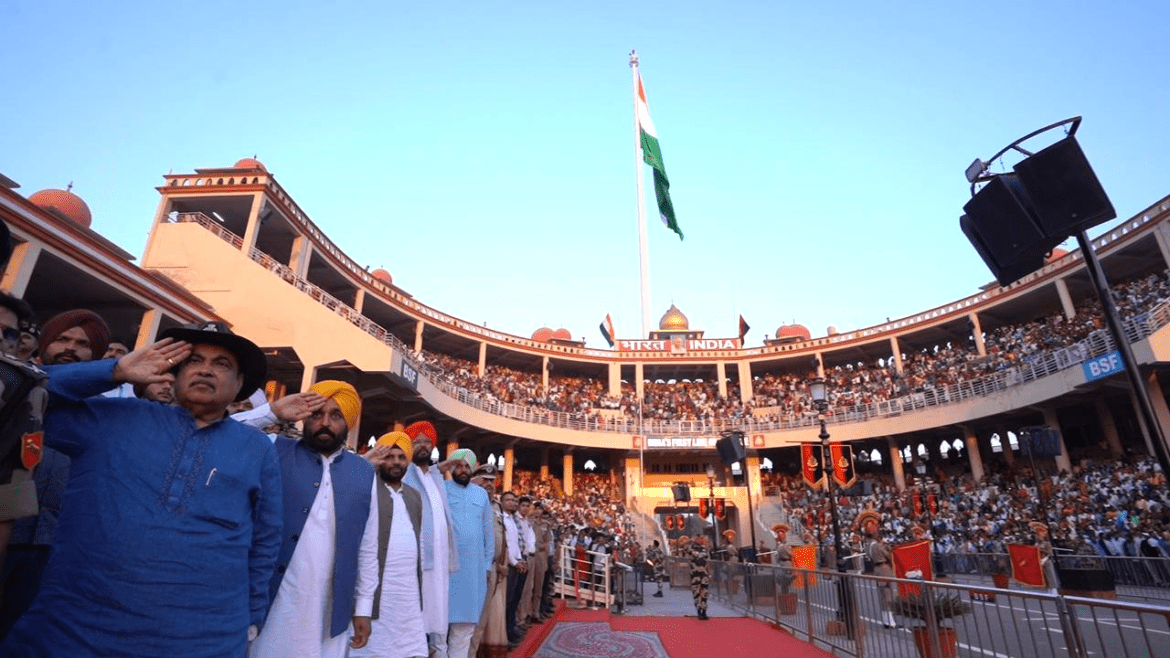AI Generated Summary
- In August of the same year, Pakistan responded by hoisting an even taller flag at 400 feet on its side of the border, sparking what was playfully dubbed a ‘flag war’ between the two neighboring nations.
- The National Highways Authority of India (NHAI) undertook the impressive task of setting up a remarkable 418-foot-tall National Flag at Attari, marking a significant moment in the country’s history.
- Member of Parliament Gurjeet Aujla provided insights into the project’s details, sharing that it cost around Rs 8 crore, and the flag was made of a special mixture of satin and cotton to withstand adverse weather conditions.
In a proud and patriotic moment, India’s Union Minister for Road Transport and Highways, Nitin Gadkari, unveiled the nation’s tallest flag near the spectators’ gallery at the Attari-Wagah Joint Check Post today. The National Highways Authority of India (NHAI) undertook the impressive task of setting up a remarkable 418-foot-tall National Flag at Attari, marking a significant moment in the country’s history.
The ceremonial event witnessed the presence of notable dignitaries, including Chief Minister Bhagwant Mann and Member of Parliament Gurjeet Aujla, who joined Nitin Gadkari in jointly unfurling the National Flag. This momentous occasion was marked by a spirit of unity and national pride.
Enlightened on a Historic Punjab Tour!!
— Nitin Gadkari (@nitin_gadkari) October 19, 2023
(19 Oct 2023)#JaiHind #HighestNationalFlagAtAttari #AttariBorder #GoldenTemple pic.twitter.com/4EdrlW0BPH
The journey to this historic moment began in March 2017 when a 360-foot-tall Tricolor was installed at the Attari-Wagah Check Post. However, in August of the same year, Pakistan responded by hoisting an even taller flag at 400 feet on its side of the border, sparking what was playfully dubbed a ‘flag war’ between the two neighboring nations.
Now, India’s new flag mast stands proudly at 418 feet, a remarkable 18 feet taller than the Pakistani Parcham-e-Sitarah-o-Hilal on the Wagah side of the border. The imposing height of this flag symbolizes the nation’s commitment to its values and its determination to showcase its pride on the global stage.
Speaking at the unveiling ceremony, Union Minister Nitin Gadkari expressed his enthusiasm and pride, saying, “I see it as a red-letter day in my life to inaugurate this most wonderful project. The NHAI has done a great job. The mast has special provisions for surveillance, which will enable Border Security Force (BSF) jawans to have a hawk’s eye on the other side of the border.”
Member of Parliament Gurjeet Aujla provided insights into the project’s details, sharing that it cost around Rs 8 crore, and the flag was made of a special mixture of satin and cotton to withstand adverse weather conditions. He also mentioned the pole mast’s interior stairs and an external hydraulic lift that would allow two BSF jawans to ascend to the top of the flag mast.
Nitin Gadkari’s visit did not end with the flag unveiling. After paying his respects at the Golden Temple, he inspected the ongoing project of the Delhi-Amritsar-Katra Greenfield Expressway (DAK) and the Amritsar Bypass. The DAK project, spanning 669 kilometers and costing Rs 40,000 crore, is set to revolutionize travel in the region.
Once completed, this expressway will enable travelers to reach Amritsar from Delhi in just four hours and Katra from Delhi in six hours, reducing the distance between Delhi and Katra by 58 kilometers. Stretching from the Kundli-Manesar-Palwal Expressway (KMP) in Delhi, the DAK Expressway will cover 399 kilometers in Punjab, with work already underway on a significant portion of it. The route will traverse through key cities and regions, including Patiala, Sangrur, Malerkotla, Ludhiana, Jalandhar, Kapurthala, and Gurudaspur.
One of the expressway’s standout features is the Asia’s longest cable-stayed bridge, measuring an impressive 1,300 meters, which spans over the Beas River in Amritsar district. This engineering marvel is set to become a symbol of India’s progress and development.
The Attari-Wagah Joint Check Post’s tallest flag and the Delhi-Amritsar-Katra Greenfield Expressway are testaments to India’s commitment to infrastructure development and national pride. These initiatives promise to enhance connectivity, boost the economy, and showcase the nation’s spirit of progress to the world. As India continues to strive for new heights, the future looks promising and bright.




